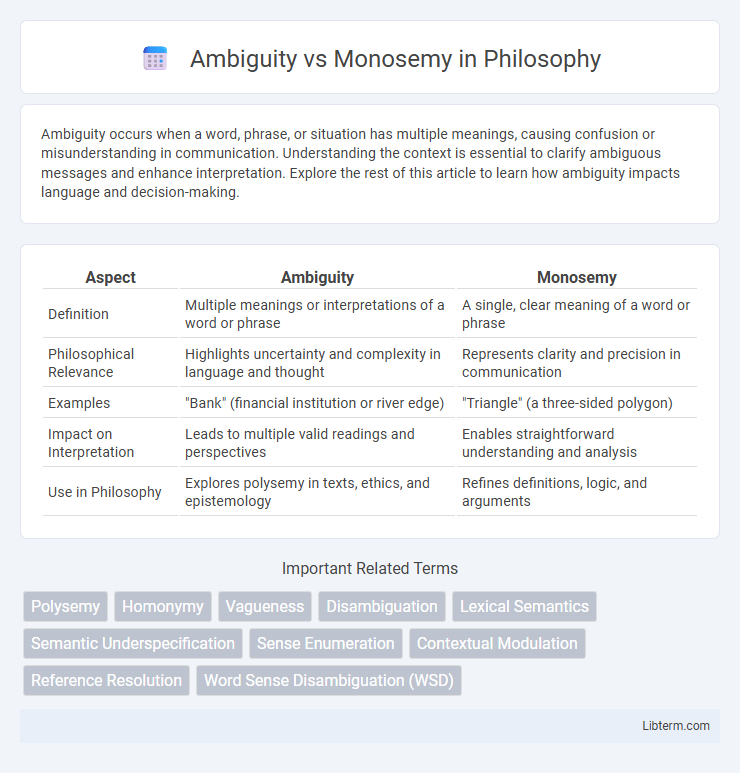Ambiguity occurs when a word, phrase, or situation has multiple meanings, causing confusion or misunderstanding in communication. Understanding the context is essential to clarify ambiguous messages and enhance interpretation. Explore the rest of this article to learn how ambiguity impacts language and decision-making.
Table of Comparison
| Aspect | Ambiguity | Monosemy |
|---|---|---|
| Definition | Multiple meanings or interpretations of a word or phrase | A single, clear meaning of a word or phrase |
| Philosophical Relevance | Highlights uncertainty and complexity in language and thought | Represents clarity and precision in communication |
| Examples | "Bank" (financial institution or river edge) | "Triangle" (a three-sided polygon) |
| Impact on Interpretation | Leads to multiple valid readings and perspectives | Enables straightforward understanding and analysis |
| Use in Philosophy | Explores polysemy in texts, ethics, and epistemology | Refines definitions, logic, and arguments |
Understanding Ambiguity in Language
Ambiguity in language occurs when a word, phrase, or sentence has multiple interpretations, which can lead to confusion or miscommunication. Lexical ambiguity arises from a single word having several meanings, while structural ambiguity results from unclear sentence syntax. Understanding ambiguity involves analyzing context and utilizing semantic cues to determine the intended meaning in communication.
Defining Monosemy: One Word, One Meaning
Monosemy refers to the linguistic phenomenon where a single word consistently carries one clear and unambiguous meaning across all contexts. This contrasts with ambiguity, where a word can have multiple interpretations depending on usage or context. Monosemous words facilitate precise communication, reducing misunderstandings in language processing and lexical semantics.
Types of Ambiguity: Lexical and Structural
Ambiguity arises when a word or sentence can have multiple meanings, distinguished as lexical and structural types. Lexical ambiguity occurs when a single word possesses multiple interpretations, such as "bank" referring to a financial institution or river edge. Structural ambiguity involves sentence construction where the arrangement of words allows for different parsing, exemplified by "I saw the man with the telescope," which can mean either the observer used a telescope or the man possessed one.
The Role of Context in Resolving Ambiguity
Context plays a crucial role in resolving ambiguity by providing additional semantic cues that narrow down possible interpretations of ambiguous words or phrases. While ambiguity arises when a term has multiple meanings, monosemy refers to a single, clear meaning, making context less critical for understanding. Effective use of syntactic, situational, and pragmatic context enables accurate disambiguation in natural language processing and human communication.
Monosemy in Specialized Terminology
Monosemy in specialized terminology ensures that each term has a single, precise meaning, reducing confusion and enhancing clarity in technical communication. This specificity is crucial in fields like medicine, law, and engineering, where ambiguous language can lead to errors or misinterpretations. The adoption of monosemous terms supports accurate knowledge exchange and effective collaboration among experts.
Ambiguity in Everyday Communication
Ambiguity in everyday communication arises when words or phrases have multiple interpretations, leading to potential misunderstandings or confusion in conversations. Context plays a crucial role in resolving ambiguity, but without clear cues, ambiguous language can hinder effective information exchange. Understanding the sources and types of ambiguity, such as lexical or structural ambiguity, improves clarity and communication efficiency.
Cognitive Processing of Ambiguous vs. Monosemic Words
Cognitive processing of ambiguous words requires increased neural resources due to multiple semantic interpretations activating simultaneously, often engaging the prefrontal cortex for disambiguation. In contrast, monosemic words, possessing a single clear meaning, elicit faster lexical access and reduced cognitive load, facilitating efficient language comprehension. Neuroimaging studies indicate greater activation in the left inferior frontal gyrus during ambiguous word processing, highlighting the brain's need to resolve semantic competition and context dependence.
Ambiguity vs. Monosemy in Language Evolution
Ambiguity in language often arises from words or phrases having multiple meanings, which can slow communication clarity but also drive linguistic creativity and evolution by enabling new interpretations. Monosemy, where each word has a single, unambiguous meaning, promotes precision and reduces misunderstandings but may limit expressive flexibility and adaptability in language change. Over time, languages tend to balance between ambiguity and monosemy, with ambiguity fostering semantic shifts and innovation while monosemy supports efficient and clear communication.
Implications for Linguistics and Natural Language Processing
Ambiguity, where a word or phrase has multiple meanings, presents significant challenges for linguistics and natural language processing (NLP), complicating tasks like parsing, semantic analysis, and machine translation. Monosemy, the condition of lexical items having a single clear meaning, facilitates more straightforward computational interpretation and language modeling, enhancing accuracy in sentiment analysis and information retrieval. Understanding the contrast between ambiguity and monosemy drives advancements in NLP algorithms, improving disambiguation techniques and the development of semantically precise language models.
Striking a Balance: Clarity and Flexibility in Language
Striking a balance between ambiguity and monosemy in language enhances both clarity and flexibility, allowing speakers to convey precise meanings while accommodating diverse interpretations. Ambiguity enables creative expression and adaptability in communication, but excessive use can lead to misunderstandings, whereas monosemy ensures exactness but may limit nuanced discourse. Effective language use strategically integrates clear, unambiguous terms with context-dependent words to optimize understanding and expressive potential.
Ambiguity Infographic

 libterm.com
libterm.com